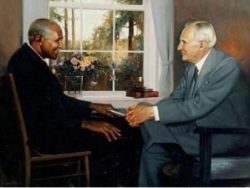Biobased Products: Renewable and Made in America
George Washington Carver and Henry Ford helped pioneer biobased products in America. Today, U.S. farmers grow more than 70 million acres of soybean plants annually, offering an abundant and renewable supply of ingredients for food, livestock feed, and hundreds of biobased products.
These commercial and industrial American-made biobased products fortify the nation’s economy by reducing petroleum content, curbing dependence on foreign oil, and providing 4.2 million American jobs through direct, indirect and induced contributions and contributed a total of $393 billion value added to the U.S. economy.
To advance these opportunities, the U.S. Congress approved landmark legislation in 2002 that calls on the federal government to buy biobased products. Federal purchasing is blazing the trail for public and private-sector use of biobased products across the nation.

The Food, Conservation, and Energy Act of 2008 (also known as the 2008 U.S. Farm Bill) expands the federal biobased program. It defines a biobased product as: a product determined by the Secretary (of Agriculture) to be a commercial or industrial product (other than food or feed) that is composed, in whole or in significant part, of biological products, including renewable domestic agricultural materials and forestry materials; or an intermediate ingredient or feedstock.
Learn more here about why biobased products are the natural choice for America.
About USB
The 77 farmer-directors of USB oversee the investments of the soy checkoff to maximize profit opportunities for all U.S. soybean farmers. These volunteers invest and leverage checkoff funds to increase the value of U.S. soy meal and oil, to ensure U.S. soybean farmers and their customers have the freedom and infrastructure to operate, and to meet the needs of U.S. soy’s customers. As stipulated in the federal Soybean Promotion, Research and Consumer Information Act, the USDA Agricultural Marketing Service has oversight responsibilities for USB and the soy checkoff.
For more information visit: http://www.unitedsoybean.org or USB’s New Uses site at http://www.unitedsoybean.org/newuses/.
Homepage product icons via flaticon.com
